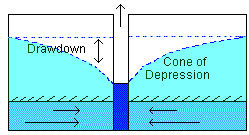

Ground water is withdrawn from wells to provide water for everything from drinking water for the home and business, to water to irrigate crops, to industrial processing water. When water is pumped from the ground, the dynamics of ground water flow change in response to this withdrawal.
When a well is installed in an unconfined aquifer, water moves from the aquifer into the well through small holes or slits in the well casing or in some types of wells, through the open bottom of the well. The level of the water in the well is the same as the water level in the aquifer. Ground water continues to flow through and around the well in one direction in response to gravity.
 When pumping begins, water begins to flow towards the well, in
contrast to the natural direction of ground water movement. In
response, the water level in the well falls below the water table ,in the surrounding aquifer. As a result, water begins to move
from the aquifer into the well. As pumping continues, the water
level in the well continues to increase until the rate of flow
into the well equals the rate of withdrawal from pumping. The
movement of water from an aquifer into a well results in the
formation of a cone of depression. The cone of depression
describes a three dimensional inverted cone surrounding the well
that represents the volume of water removed as a result of
pumping. Drawdown is the vertical drop in the height between the
water level in the well prior to pumping, and the water level in
the well during pumping.
When pumping begins, water begins to flow towards the well, in
contrast to the natural direction of ground water movement. In
response, the water level in the well falls below the water table ,in the surrounding aquifer. As a result, water begins to move
from the aquifer into the well. As pumping continues, the water
level in the well continues to increase until the rate of flow
into the well equals the rate of withdrawal from pumping. The
movement of water from an aquifer into a well results in the
formation of a cone of depression. The cone of depression
describes a three dimensional inverted cone surrounding the well
that represents the volume of water removed as a result of
pumping. Drawdown is the vertical drop in the height between the
water level in the well prior to pumping, and the water level in
the well during pumping.
This information is used in a number of ways:
|
|
|

| © Copyright |